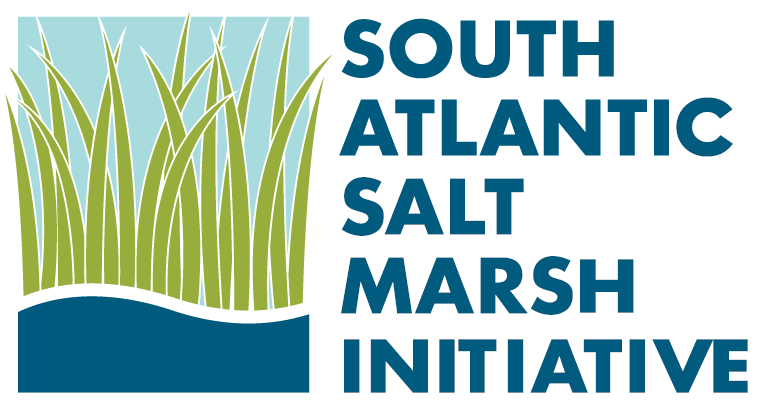Improving our Water Quality on Edisto Island
Protecting Edisto, as a whole, means looking out beyond the land, towards the ocean, rivers, and creeks that envelope our Island. The threats that impact our waterways in many ways differ from those that EIOLT fights through land protection. They present new challenges that need to be overcome. Yet, at the same time, they present new opportunities to keep Edisto, Edisto.
Edisto Island Watershed-Based Plan
The waterways on and around Edisto Island are affected by pollution from several different sources. There are currently 24 locations across the watershed that have levels of bacteria and turbidity exceeding the acceptable limits during at least some part of the year. As a result, there are restrictions on where shellfish (including oysters) can be harvested throughout the watershed. In order to re-open the closed shellfish beds to harvest, pollution levels need to decrease. To reduce turbidity, we need to address nutrient loading and prevent streambank erosion. That’s a big task and, as a land trust, water quality is not our expertise. So, EIOLT partnered with Clemson Extension, SC-DNR, the ACE Basin National Estuarine Research Reserve, SC Sea Grant Consortium, and the Town of Edisto Beach to create the Edisto Island Watershed-Based Plan (EIWBP), which was funded by a grant from SC-DHEC and published in December 2022. The EIWBP assesses potential pollution sources and provides recommendations on how to address each issue. The EIWBP was the first step towards finding ways to reduce pollution and protect healthy waterways for the Edisto community.
Click here to view the Edisto Island Watershed-Based Plan’s website
The creation of the Edisto Island Watershed-Based Plan was funded by a Watershed Plan Development Grant from the Drinking Water State Revolving Fund set-aside and administered by the South Carolina Department of Health and Environmental Control.
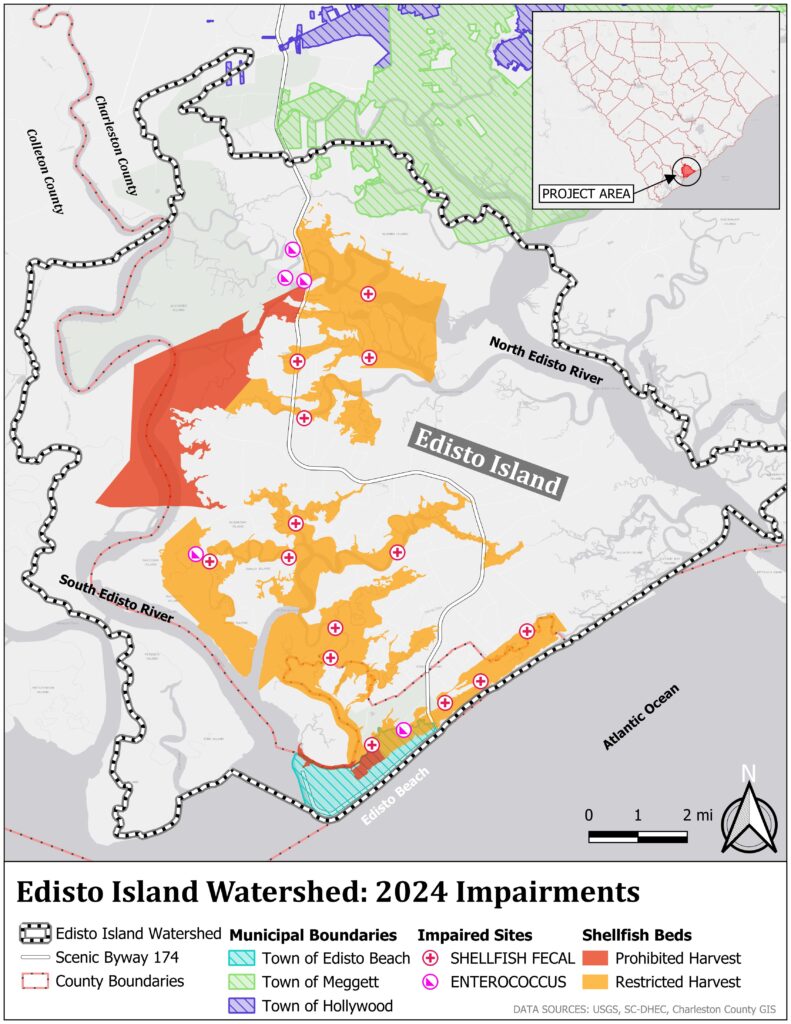
Edisto Island Septic System Improvement and Assistance Program
The Edisto Island Watershed-Based Plan highlights bacteria as the primary impairment for the Edisto Island Watershed. The Plan also identifies failing or poorly maintained septic systems as the major source of bacterial pollution. Increased levels of fecal coliform, enterococcus, and other bacteria, can result in negative health impacts and reduced recreational opportunities for everyone who uses our tidal waterways and can cause hardships for the members of the community who rely on our creeks to put food on the table. To tackle reducing the bacterial load in the watershed, EIOLT created the Edisto Island Septic System Improvement and Assistance Program to do two things: (1) educate all septic owners on Edisto Island about the importance of septic system maintenance and (2) to fund the replacement or repair of septic systems for residents who can use the financial help.
This program began in summer of 2022 with a grant from the Healthy Harbors Fund, which is managed by the Coastal Community Foundation, and has since been expanded in scope and scale for 2024 with a second grant from the Healthy Harbors Fund in combination with a three-year EPA Section 319 grant via SC-DHEC and a Charleston County Community Investment grant. EIOLT staff manage the program and work closely with SC-DHEC staff and our program partners (including: Clemson Extension, the ACE Basin NERR, Island Septic Systems, and the Town of Edisto Beach) to make progress towards reducing bacterial pollution in our tidal creeks.
Be Septic Safe
As homeowners, visitors, and residents on the beautiful and rural Edisto Island, it is each of our responsibilities to properly maintain and care for our septic systems. If we fail to do so, not only do we risk incurring expensive repair bills and days, or even weeks, without plumbing, but we also may be endangering the health of ourselves, our families, our neighbors, and our community as well as threatening the integrity of the waterways we rely on for recreation, seafood, and ecosystem services. Do you know where your septic tank and drain field are buried? Do you know what common household products are and are not septic safe? Do you know the principles behind how a septic system works? Do you know the signs to look out for to know when your septic system is failing or damaged? How old is your septic system? When was the last time you had your septic system inspected and pumped-out?
Click Here to Learn how to Properly Maintain your Septic System
Financial Assistance
Replacing a failed septic system isn’t cheap. Our Septic System Financial Assistance Program was created to help homeowners when they may not be able to afford to inspect, repair, or replace their septic system. The program prioritizes helping the members of our community with the greatest need, whose systems are failing or outdated, and those who live near impaired waterways and on soils prone to flooding. We’re also able to assist residents on heir’s properties or long-term rental properties in both Charleston and Colleton Counties. The program provides a free septic system inspection and pump-out to qualified applicants. If the septic system is in a priority area and the inspection finds it to be damaged or failing, the financial assistance program may be able to repair or replace the system, at zero-cost to the homeowner. The program can also cover the costs of repairs to any damaged wastewater plumbing leading into the septic system.
Click Here to Apply for Financial Assistance through EIOLT’s Septic Assistance Program
The Edisto Island Septic System Improvement and Assistance Program is administered by EIOLT and funded by the Coastal Community Foundation’s Healthy Harbors Fund, Charleston County’s Community Investment Fund, and the United States Environmental Protection Agency and made possible by the South Carolina Department of Health and Environmental Control.

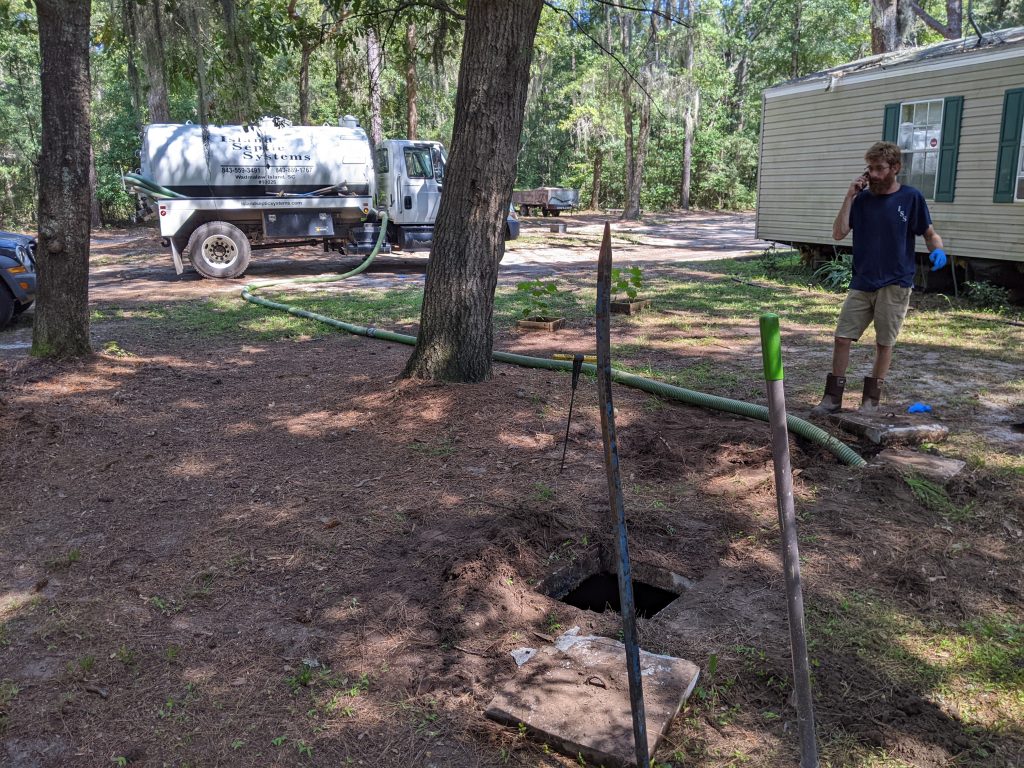
Charleston County’s Existing Well and Septic Upgrade Program
As stated on Charleston County’s website, “The Community Services Department has limited funding available for Charleston County residents living in owner-occupied housing and in need of an upgrade to existing well and/or septic systems. All applicants are required to go through a federal certification process to determine eligibility mandated by the U.S. Department of Housing and Urban Development.” If you are a Charleston County resident and you need an upgrade to your home’s well and/or septic system, you can apply for an upgrade with the County. EIOLT’s program does not have funding for improving wells, so the County’s program can help you financially if you are in need of a well upgrade. Additionally, if you applied to EIOLT for a septic system improvement and our program was not able to assist you financially, then Charleston County may still be able to provide you financial assistance for a septic system upgrade.
Click Here to Apply online to Charleston County for a Well or Septic System Upgrade
Click here for a printable Paper Application of the above
Saltwater Adopt-A-Stream
In July of 2021, SC-DHEC hosted the very first training for the Tidal Saltwater Monitoring branch of their SC Adopt-a-Stream citizen-science program right here on Edisto Island. That first workshop was attended primarily by EIOLT staff, board members, and volunteers! The SC Adopt-a-Stream program gives everyone the opportunity to receive training and start monitoring water quality in our local tidal creeks. You can monitor from a dock, pier, boat landing, or even your boat! This program extends across the entire coast of South Carolina but the volunteers of the Edisto Pluff Mud Patrol are the folks making sure our waterways on Edisto Island are staying clean!
Click here to learn more about the SC Adopt-a-Stream Program
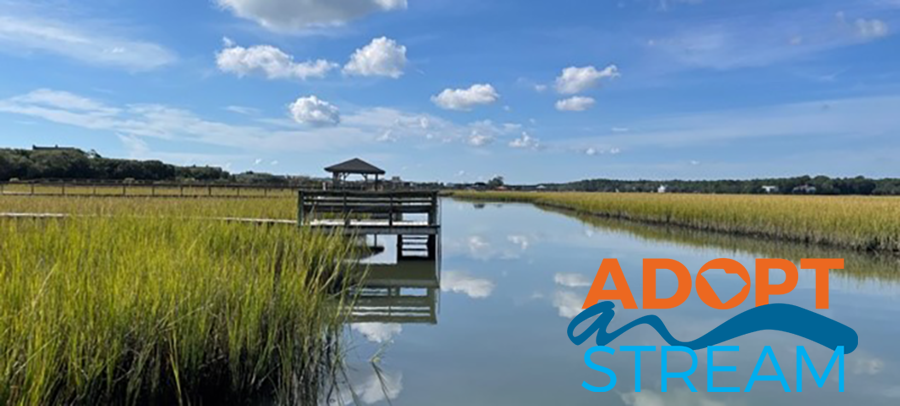
Tackling Turbidity
Bacterial pollution is one half of the water quality issue Edisto Island is facing. The other half is turbidity. Turbidity is the measure of the clarity of our waterways. Turbidity can be caused by sediment and photosynthetic plankton, as well as other things, suspended in the water column. Our tidal creeks around Edisto Island are naturally more turbid than most. However, excessive turbidity can harm our tidal ecosystems and impact fisheries. If the water is too turbid, it can change things like water temperature, dissolved oxygen levels, and visibility and impact which species thrive or flounder (pun intended) in our creeks. It can also lead to algal blooms which exacerbate these impacts. These can have ripple effects throughout the ecosystem with unpredictable consequences. Excess sediment in the water can be attributed to erosion, both on land and within the water channel. Construction, development, and land clearing lead to soil disturbance which allows sediment to wash into our waterways. Past alterations to the way certain tidal creeks flow and the failure of some recreational boaters to adhere to no-wake-zone laws both present a continuous source of erosion and suspended sediment within our waterways. This increased sediment load in the water column brings with it nutrients which promotes the growth of algae, and too much algae also increases turbidity. Nutrient runoff from fertilizers, failing septic systems, and pet and livestock waste is, itself, invisible but promotes algal growth, which then increases turbidity. In order to lower turbidity in our impacted waterways, we need to address each of these issues one by one.
Living Shorelines
As defined by SC regulations a living shoreline is “a shoreline stabilization approach utilized in intertidal wetland environments that maintains, restores, and/or enhances natural estuarine processes through the strategic placement of native vegetation and/or use of green infrastructure. Living shorelines promote wetland resiliency and water quality and enhance the diverse intertidal habitat.” Living shorelines are a great way to fight erosion of our marshes and uplands while reducing sediment and thus lowering turbidity in our waterways. Whenever possible, EIOLT strongly recommends the creation of a living shoreline to fight erosion in our tidal creeks rather than the use of bulkheads or rip-rap revetments. If you already have a revetment or bulkhead, incorporating some of the features of a living shoreline into it will almost always increase both the longevity and effectiveness of a traditional erosion control structure.
Living shorelines in the Lowcountry typically promote the growth of oysters reefs along creek banks. These oyster reefs provide a whole host of benefits and help improve water quality in several ways. Oyster reefs act as breakwaters, which scatter energetic waves caused by wind and boat wake. The reefs also slow this water down and promote sediment to fall out of suspension and settle behind the reef. This is called accretion, the opposite of erosion. As sediment builds up behind the reef, marsh grasses are now able to grow behind the reef and hold that sediment in place. The marsh grasses then enhance the breakwater effect and accelerate accretion. The marsh grasses eventually fill up the space between the oyster reef and the upland, creating a salt marsh. The salt marsh is then able to capture sediment and nutrient run-off from the uplands and filters sediment out of the water column on high tides. A healthy salt marsh not only provides these turbidity reducing functions but also buffers against storm surge, sequesters atmospheric carbon, and provides critical habitat to both marine life and wildlife.
Click here to Learn more about Living Shorelines
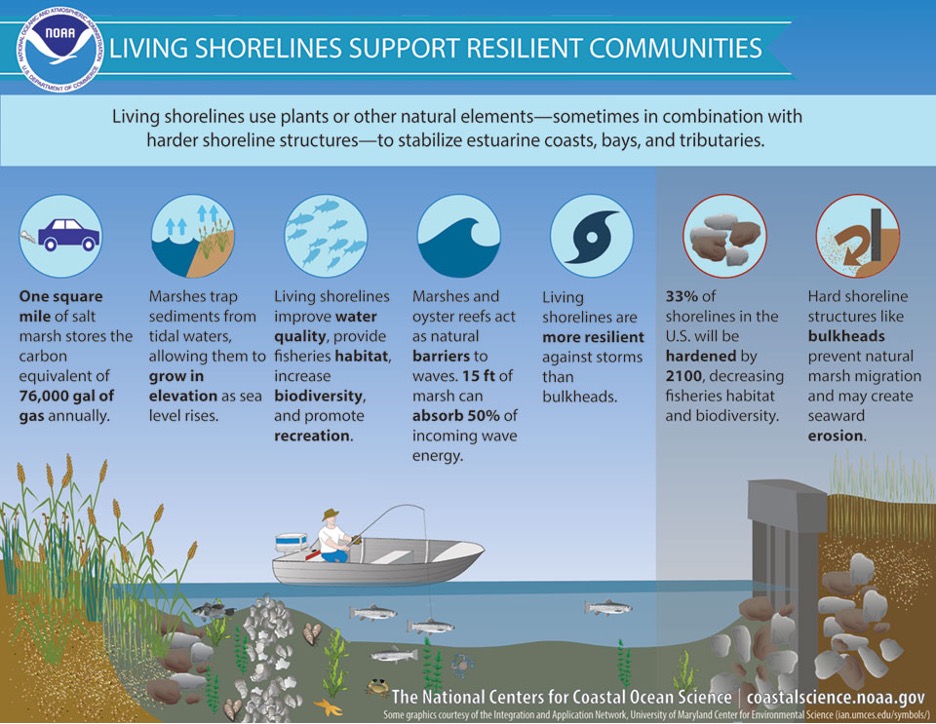
Many of our salt marshes on Edisto Island are healthy and already function as great natural living shorelines. However, some have been damaged by changes in land uses, past excessive shellfish harvests, and increased erosion. These damaged salt marshes often need a helping hand to get them back on the right track to start fighting erosion. Thankfully, there are several state, federal, and nonprofit programs working to fix this problem and opportunities for private landowners to build living shorelines on their own properties.
SCORE
The SC Department of Natural Resources (SCDNR) created the South Carolina Oyster Recycling and Enhancement (SCORE) Program to promote oyster reef growth, create estuarine habitat, improve intertidal water quality, and educate the public on the importance of oysters. SCORE has set up designated oyster shell drop off locations all along the SC coastline to collect empty oyster shells from recreational harvesters, restaurants, events, and from everyone else in the state. These shells are then brought to a recycling center where they are cleaned of trash and allowed to dry for at least six months. The cleaning keeps pollution out our waterways and the drying sterilizes the shells of any pathogens or bacterial pollutants they may be carrying. This recycling process is necessary because the harvest of oysters takes oyster shells out of the environment. The empty shells of oysters are a critical substrate needed for new oysters to establish. So we must return harvested oyster shells back to the banks of tidal creeks in order to maintain a sustainable oyster fishery and for new reefs to establish and thrive. Oyster reef habitat restoration is most often limited by the supply of useable shell. So every shell counts! SCORE helps establish new oyster reefs within our tidal creeks by building arrays of bagged shells in suitable sites along public properties throughout the Lowcountry.
You can help SCORE by bringing oyster shells to the designated drop off sites, by volunteering to clean and bag dried oyster shells, or by signing up to help build oyster reefs around the state.
Click Here to learn more about SCORE or to Volunteer to build Oyster Reefs
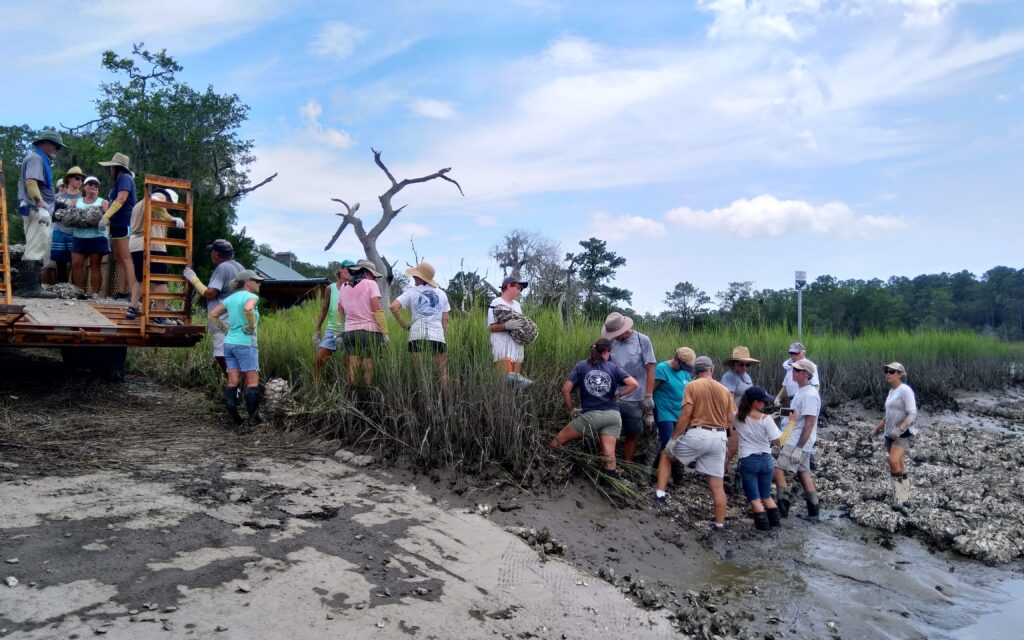
From Seeds to Shoreline
The SC Sea Grant Consortium, SCDNR, and Clemson Extension have partnered together to create the From Seeds to Shoreline program in order to teach K-12 students about the importance of our salt marshes and give them hands on experience with salt marsh restoration. The programs takes students through all the steps of a marsh restoration project, from collecting Cordgrass seeds, to germinating and growing those seeds, to transplanting seedlings into the marsh, while they learn all along the way about the invaluable ecosystem services our salt marshes provide.
Click here to learn more about the From Seeds to Shoreline program

Protecting your Property with a Living Shoreline
The SC Department of Health and Environmental Control recently implemented new regulations and permitting procedures in 2021 to facilitate private landowners designing and building living shorelines in tidal systems along their property. These enhanced regulations were informed by the South Carolina Living Shorelines Working Group, of which EIOLT is a participating member. This streamlined permitting procedure will hopefully allow living shorelines to become a viable, cost-effective, sustainable, habitat enhancing, and widely implemented alternative to bulkheads, rip-rap revetments, and other hardened erosion control structures throughout the Lowcountry of South Carolina and make them an option that is accessible to more landowners than ever before.
Click here to Learn more about having your own Living Shoreline Built
Making Room for Marsh Migration
Looking forward beyond the water quality issues of today, our coastal wetlands, our salt marshes, and the ecosystem services they provide which we depend upon, are expected to be in peril. Not just on Edisto Island but across the entire South Atlantic Coastline. As the years tick by, the predictions for sea level rise timing and magnitude in the Lowcountry become more certain. As the seas rise, tidal flooding will become chronic, bank erosion will increase, and freshwater wetlands and low-lying uplands will begin to convert to salt marsh. This process is already underway and has been taking place for at least the last 100 years. From this it can be observed that the natural, sloping topographies along our tidal creeks will readily convert to salt marsh at pace with recent rates of sea level rise. However, the predicted rate of future sea level rise in the next century is far more rapid than what has occurred historically. Further, even if conversion of uplands to saltmarsh can outpace the rising tides, there will more than likely not be enough sediment suspended in the water for accretion rates to outpace sea level rise. Accretion is what allows a marsh to build up its soils and grow taller. If it can’t accrete new soil, it will drown. This would mean that the salt marshes of tomorrow will depend on their ability to move inland. If they can’t, they will disappear. The overwhelming need to conserve room for our salt marshes to migrate inland is thus apparent. The Edisto Island Open Land Trust is committed to doing what we can on Edisto Island to make room for our marshes to migrate.
Conserving and Creating Marsh Migration Space on Edisto Island
Conservation easements
EIOLT actively conserves marsh migration space on Edisto Island through the terms in place within our conservation easements. We encourage easement donors to emplace shoreline buffers and setbacks on their properties. These prevent impervious surfaces and adverse topographical alterations within the regions of the property that will serve as marsh migration space. Further, we recommend building envelopes for permitted residential structures outside of areas of marsh migration space. This not only avoids deteriorating the capacity of existing marsh migration space but also helps the landowner avoid future impacts from sea level rise. Additionally, structures like seawalls, berms, and dikes alter the natural, sloping topography of the landscape and impede, or even prevent, the marsh’s ability to migrate upland. We encourage easement donors to prohibit these types of erosion control structures under normal circumstances. Simultaneously, we make it explicit within our conservation easements that living shorelines are a permitted alternative for shoreline stabilization.
Click here to learn about our Conservation Easements
Saltwater Wetland Mitigation Banks
Beyond the protections afforded by conservation easements, EIOLT is also beginning to explore how we can facilitate the restoration of impaired marshlands, the enhancement of existing marsh migration space, and the creation of new marsh migration space. One of the means we have found thus far to accomplish this goal is through the creation of Saltwater Wetland Mitigation Banks. Wetland mitigation banks are a facet of the federal Clean Water Act (CWA). In their most basic form, mitigation bank projects entail an already damaged wetland being restored back to its natural functionality. The restored wetland property is then placed under conservation protections, generally a conservation easement, in order to keep it from being damaged again. These mitigation banks are created to provide offsets for permitted damages to wetlands elsewhere in the surrounding watersheds, those damages having been permitted to take place by the United States Army Corps of Engineers and thus requiring offsets as part of the no-net-loss of wetlands requirement of the CWA. Mitigation banks generate mitigation credits for specific wetland types. These mitigation credits can then be purchased by permittees to offset their permitted wetland damages. Most mitigation banks restore freshwater wetlands. However, although rare, saltwater wetland mitigation banks do exist. They are few and far between in the Lowcountry because, ostensibly, only government agencies are able to damage marshlands in South Carolina to the extent that would require offsets. Thus the demand for this type of mitigation credit is often low, and the number of banks few, unless there are major coastal infrastructure plans on the horizon. Currently, major infrastructure plans are indeed on the horizon for Charleston County and the projected future demand for saltwater wetland mitigation credits is high. As such, several saltwater wetland mitigation banks have been proposed in or along the Edisto Island Watershed.
EIOLT is currently partnered on the creation of a saltwater wetland mitigation bank on an existing conserved easement property we steward on Edisto Island. We are also investigating whether it will be feasible, from a capacity standpoint, for the organization to partner on additional saltwater wetland mitigation banks on Edisto Island. We believe these saltwater banks provide not only an opportunity to protect more ecologically important lands on Edisto Island but also an excellent chance to improve the Island’s capacity to support marsh migration. These banks have the ecological objective of restoring damaged salt marsh back to full functionality. These marshes will thus be healthier and better able to migrate with sea level rise. The mitigation bank projects also have the capacity to reshape the previously altered topography within and surrounding the marsh in order to sculpt more natural topography, which will create marsh migration space for the newly restored marsh. EIOLT views these banks as a valuable opportunity to not only conserve marsh migration space, but to recreate it where it was previously destroyed.
Click here to learn about Mitigation Banks
South Atlantic Salt March Initiative
The South Atlantic Salt Marsh Initiative (SASMI) is a coalition of federal, state, and local government agencies, universities, environmental advocacy groups, non-profit organizations, land trusts (to include EIOLT) and other entities from North Carolina, South Carolina, Georgia, and Florida who have partnered to create and help implement the 10-year SASMI Plan. As described by SASMI on their website, “The SASMI Plan is the pathway to the protection, restoration and migration of this great expanse of salt marsh. It reflects the culmination of two years of intensive study, dialogue, and deliberations. This includes understanding that while each of the four SASMI states faces many of the same challenges, these challenges likely vary in severity and extent at the state and local levels. Therefore, achieving landscape-scale success with the regional plan will necessitate a tailored approach to the plan’s implementation that is formulated in partnership and coordination with agencies and other partners at the state and local levels. The strategies included in the plan are intended to be a road map for elected officials, state and federal agencies, communities, NGOs, academic partners and others to work together to ensure the long-term abundance, health and resilience of this vital natural resource.” EIOLT is proud to be a participating member of SASMI. We’re excited to see the future success of the 10-year plan and to create partnerships towards its implementation in the South Carolina Lowcountry.
Marsh Forward!
Click here to learn more about SASMI
